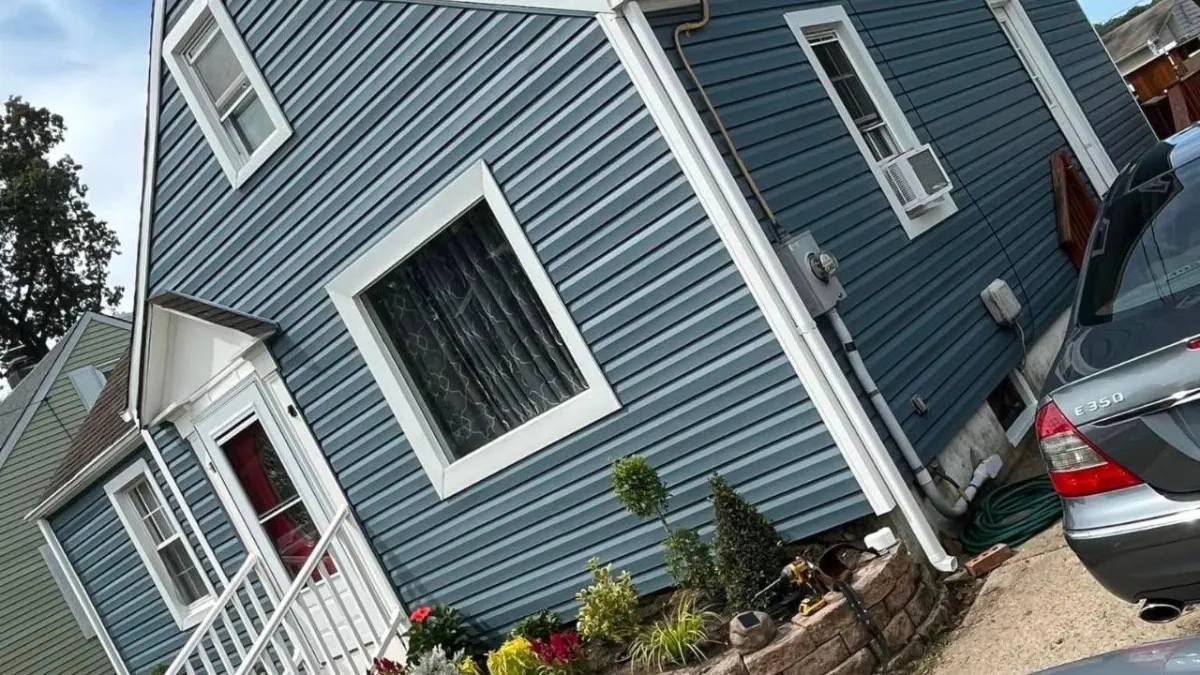Blogs

Why Should I Consider New Siding for My Home's Exterior?
You should consider new siding or your home's exterior because it enhances curb appeal, improves energy efficiency, increases property value, and provides better protection against the elements, all while reducing maintenance costs over time.
When it comes to home improvements, the exterior is often overlooked in favor of interior upgrades. However, updating your home's siding can offer significant benefits that go beyond aesthetics. New siding can transform the look of your home, increase its value, improve energy efficiency, and protect it from the elements.
This comprehensive guide explores why investing in new siding is a smart decision for any homeowner. If you’re considering a home improvement project, Northeast Exteriors is here to provide exceptional service tailored to your needs.
Key Takeaways:
New siding can significantly improve your home's curb appeal and value.
Properly insulated siding enhances energy efficiency and reduces utility bills.
High-quality siding protects your home from weather-related damage and pests.
Modern siding materials require minimal maintenance and offer long-term durability.
Installing new siding allows for the identification and prevention of underlying issues.
The Benefits of Installing New Siding on Your Home
1. Improved Curb Appeal and Home Value
New siding dramatically enhances your home's exterior, making it look clean, modern, and well-maintained. This boost in curb appeal can increase your home’s value by up to 80% of the project cost, providing an excellent return on investment if you decide to sell.
2. Enhanced Energy Efficiency
Replacing old siding with a new, properly insulated system can significantly improve your home's energy efficiency. This upgrade reduces your monthly energy bills and makes your living spaces more comfortable by maintaining a consistent indoor temperature.
3. Protection from Weather Elements
Siding is a crucial component of your home's waterproof envelope, shielding it from rain, snow, and harsh winds. High-quality siding helps prevent water damage, mold, and pest infestations, thereby increasing the longevity of your home.
4. Minimal Maintenance
Modern siding materials, such as vinyl and fiber cement, are designed to last for decades with minimal maintenance. These materials resist cracking, warping, and other issues that can compromise the integrity of your home’s exterior.
5. Identification and Prevention of Underlying Issues
Installing new siding provides an opportunity to inspect and address any existing problems, such as water leaks or rot, before they escalate into costly repairs. A professional installation ensures that your home is properly sealed and protected.
How New Siding Can Increase Your Home’s Energy Efficiency
New siding plays a crucial role in improving your home's energy efficiency by providing better insulation and reducing heat loss. This upgrade not only enhances comfort but also lowers your energy bills throughout the year. Here’s how new siding achieves these benefits:
Improved Insulation
Modern siding materials, such as insulated vinyl or fiber cement, offer superior insulation compared to older siding types. They create a thermal barrier that helps regulate indoor temperatures, keeping your home cooler in summer and warmer in winter.
Sealing Air Leaks
Over time, old siding can develop cracks or gaps that allow air to leak in and out of your home. New siding installation includes sealing these areas properly, reducing drafts and improving overall air tightness.
Reduced Heating and Cooling Costs
By minimizing heat transfer through your walls, new siding reduces the workload on your HVAC system. This efficiency can lead to significant savings on your monthly heating and cooling bills.
Energy-Efficient Options
Certain siding materials, such as insulated vinyl or fiber cement, are designed with energy efficiency in mind. They are engineered to resist thermal bridging, which occurs when heat moves through materials with different levels of thermal conductivity.
Environmental Benefits
Lower energy consumption not only saves you money but also reduces your home’s carbon footprint. Energy-efficient siding contributes to a greener lifestyle by conserving natural resources and reducing greenhouse gas emissions.
Long-Term Savings
While the initial investment in new siding may seem significant, the long-term savings in energy costs and maintenance expenses make it a financially sound decision for many homeowners.
Installing new siding is an investment that pays off in multiple ways, from increased comfort and lower utility bills to a reduced environmental impact.
Choosing the Best Siding Material for Your Home
Choosing the best siding material for your home involves considering several factors to ensure it meets your needs for durability, maintenance, and aesthetic appeal. Here’s a guide to help you make an informed decision:
Vinyl Siding
One of the most popular choices due to its affordability, low maintenance, and versatility in colors and styles. Vinyl siding is durable, resistant to rot and insects, and easy to clean with simple soap and water.
Fiber Cement
Known for its durability and ability to mimic the look of wood or masonry without the maintenance requirements. Fiber cement is fire-resistant, moisture-resistant, and holds paint well, offering long-lasting protection and aesthetic appeal.
Wood Siding
Offers a natural, timeless look that enhances architectural charm. Wood siding is available in various types, such as cedar, pine, and redwood, each with unique grains and finishes. It requires regular maintenance, including staining or painting, to protect against moisture and pests.
Metal Siding
Provides durability and minimal maintenance, ideal for contemporary or industrial-style homes. Metal siding, such as aluminum or steel, is resistant to fire, insects, and rot, but may require occasional repainting to maintain its appearance.
Engineered Wood
Combines the natural beauty of wood with enhanced durability and lower maintenance. Engineered wood siding is made from wood fibers bonded with resins and treated to resist moisture, insects, and UV damage, offering a more stable option than traditional wood.
Brick or Stone Veneer
Offers a classic, elegant look with exceptional durability and minimal maintenance. Brick and stone veneer siding enhance curb appeal and provide excellent insulation, though they are generally more expensive and require professional installation.
Choosing the best siding material involves assessing your budget, climate considerations, desired maintenance level, and architectural style preferences.
Signs It’s Time to Replace Your Home’s Siding
Knowing when it’s time to replace your home’s siding is crucial for maintaining its structural integrity and aesthetic appeal. Here are key signs that indicate it may be time for a siding replacement:
Visible Damage: Cracks, chips, or holes in your siding can allow moisture to penetrate, leading to water damage, mold growth, and structural issues. Inspect your siding regularly for signs of wear and tear.
Fading or Discoloration: Over time, exposure to the sun and elements can cause siding to fade or change color unevenly. Faded siding not only detracts from your home’s curb appeal but may also indicate reduced effectiveness in protecting your home.
Warping or Buckling: Warped or buckled siding panels are signs of moisture infiltration or improper installation. These issues can compromise your home’s insulation and lead to further damage if left unaddressed.
Peeling Paint or Wallpaper Inside: If you notice peeling paint or wallpaper inside your home, it could be a sign of moisture getting through your siding. This indicates a need for inspection and potential replacement to prevent further interior damage.
High Energy Bills: Poorly insulated or damaged siding can contribute to increased heating and cooling costs. If you notice a spike in your energy bills without a change in usage habits, your siding’s insulation may be compromised.
Mold or Mildew Growth: Excess moisture trapped behind siding can promote mold and mildew growth, which not only damages your siding but also poses health risks to your household members.
Rot or Decay: Soft or crumbling areas on your siding indicate rot or decay, usually caused by prolonged exposure to moisture. Rotting siding should be replaced promptly to prevent structural damage to your home.
Aging Siding: Even if there are no obvious signs of damage, siding typically has a lifespan of 20 to 40 years depending on the material. Aging siding may not provide adequate protection or energy efficiency, warranting replacement.
Regularly inspecting your home’s siding and addressing these signs promptly can help you avoid more extensive repairs or replacements in the future.
FAQs
1. How long does new siding last?
Modern siding materials can last between 20 to 50 years, depending on the type and quality of the material. Regular maintenance and proper installation can extend the lifespan of your siding.
2. What is the most energy-efficient siding material?
Insulated vinyl siding is one of the most energy-efficient options available. It provides an extra layer of insulation, reducing heat loss and improving your home's overall energy efficiency.
3. How much does it cost to install new siding?
The cost of installing new siding varies based on the material, the size of your home, and the complexity of the project. On average, homeowners can expect to spend between $5,000 and $15,000 for a complete siding installation.
4. Can I install new siding over old siding?
In some cases, new siding can be installed over existing siding. However, it is essential to inspect the old siding for damage or rot before proceeding. Consulting with a professional can help determine the best approach for your home.
5. How do I choose the right siding color?
When selecting a siding color, consider your home's architectural style, the surrounding landscape, and your personal preferences. Neutral colors like beige, gray, and white are versatile and timeless, while bold colors can make a statement. Sampling a few colors on your home before making a final decision can help ensure you choose the right one.
Transform Your Home with Northeast Exteriors
Investing in new siding is a smart decision that offers numerous benefits, from enhanced curb appeal to improved energy efficiency. Northeast Exteriors, based in Palmyra, New Jersey, is committed to providing high-quality siding solutions tailored to your needs. Our family-owned company prioritizes your satisfaction, ensuring a transparent buying experience and custom solutions that meet your unique requirements. Trust us to transform your home with quality in every detail.
Contact us now for a free estimate and experience the Northeast Exteriors difference. Let's make your home the envy of the neighborhood. Call us today!
Hours
Monday: 8:00AM - 6:00PM
Tuesday: 8:00AM - 6:00PM
Wednesday: 8:00AM - 6:00PM
Thursday: 8:00AM - 6:00PM
Friday: 8:00AM - 6:00PM
Copyright © Northeast Exteriors 2025. All Rights Reserved. Privacy Policy. Terms & Conditions. Web Design by Fused Media





